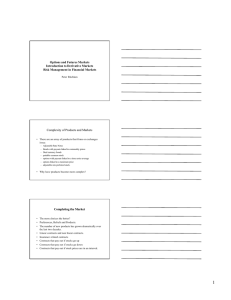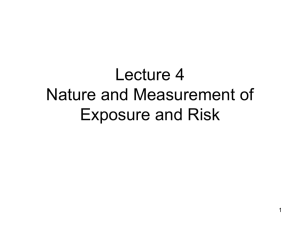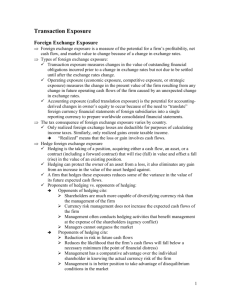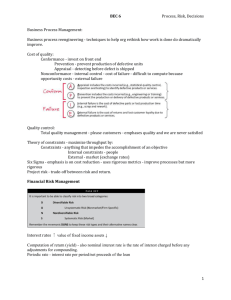Managing Transaction Exposure Ch.10(a) Managing Accounting Exposure • Hedging transaction exposure
advertisement
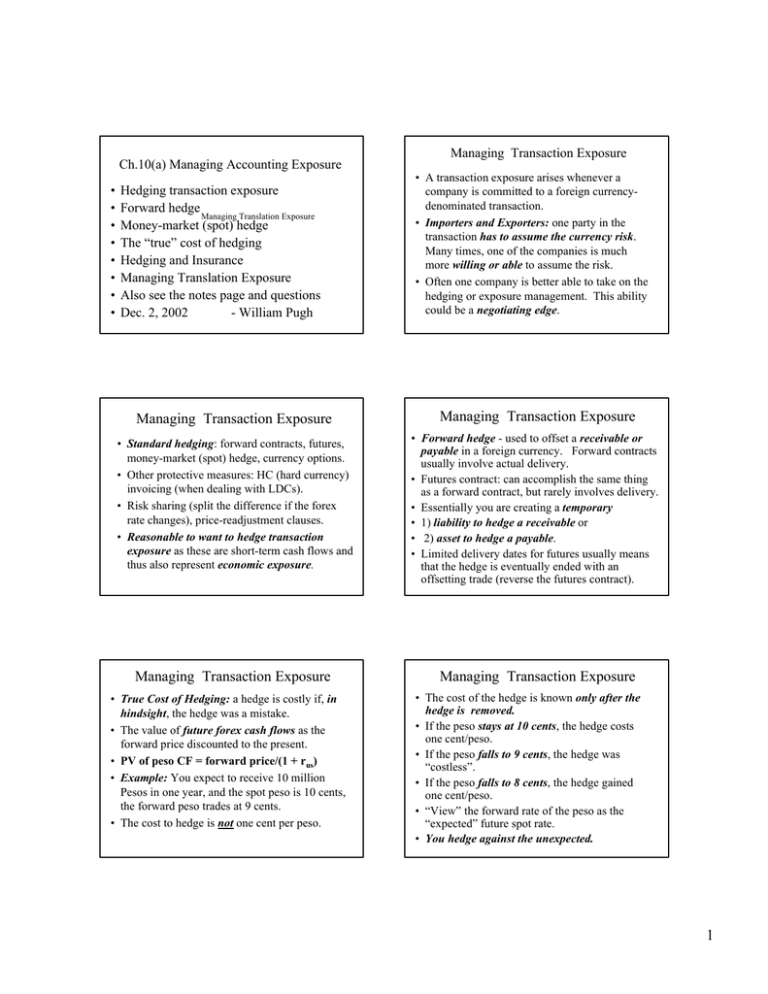
Ch.10(a) Managing Accounting Exposure • • • • • • • • Hedging transaction exposure Forward hedge Managing Translation Exposure Money-market (spot) hedge The “true” cost of hedging Hedging and Insurance Managing Translation Exposure Also see the notes page and questions Dec. 2, 2002 - William Pugh Managing Transaction Exposure • A transaction exposure arises whenever a company is committed to a foreign currencydenominated transaction. • Importers and Exporters: one party in the transaction has to assume the currency risk. Many times, one of the companies is much more willing or able to assume the risk. • Often one company is better able to take on the hedging or exposure management. This ability could be a negotiating edge. Managing Transaction Exposure Managing Transaction Exposure • Standard hedging: forward contracts, futures, money-market (spot) hedge, currency options. • Other protective measures: HC (hard currency) invoicing (when dealing with LDCs). • Risk sharing (split the difference if the forex rate changes), price-readjustment clauses. • Reasonable to want to hedge transaction exposure as these are short-term cash flows and thus also represent economic exposure. • Forward hedge - used to offset a receivable or payable in a foreign currency. Forward contracts usually involve actual delivery. • Futures contract: can accomplish the same thing as a forward contract, but rarely involves delivery. • Essentially you are creating a temporary • 1) liability to hedge a receivable or • 2) asset to hedge a payable. • Limited delivery dates for futures usually means that the hedge is eventually ended with an offsetting trade (reverse the futures contract). Managing Transaction Exposure Managing Transaction Exposure • True Cost of Hedging: a hedge is costly if, in hindsight, the hedge was a mistake. • The value of future forex cash flows as the forward price discounted to the present. • PV of peso CF = forward price/(1 + rus) • Example: You expect to receive 10 million Pesos in one year, and the spot peso is 10 cents, the forward peso trades at 9 cents. • The cost to hedge is not one cent per peso. • The cost of the hedge is known only after the hedge is removed. • If the peso stays at 10 cents, the hedge costs one cent/peso. • If the peso falls to 9 cents, the hedge was “costless”. • If the peso falls to 8 cents, the hedge gained one cent/peso. • “View” the forward rate of the peso as the “expected” future spot rate. • You hedge against the unexpected. 1 Managing Transaction Exposure • True Cost of Hedging is simply the cost of transacting at rate ‘f1’ compared to not having hedged and transacting at rate e1 • The Formula is • cost = (f1 - e1)/e1 • where e1 = future spot rate • It is not (f1 - e0)/e0. • or even (f1 - e1)/e0. Text is wrong too. Managing Transaction Exposure • Suppose you sell to a Mexican firm an order worth P 10 million with the spot peso at 10 cents. You give the firm six months to pay. You decide to hedge. The six-month forward rate you are quoted is 9.2 cents. You feel the banks are taking advantage of you. Are you right? • The Cost of the Hedge however is not the 0.8 cent/peso - that rate is what the market says the Peso is worth for a six month hedge (what if you owed Pesos to Cemex?) Managing Transaction Exposure Hedging and Insurance • Money market (or spot) hedge consists of offsetting a (1) receivable or (2) payable in a foreign currency by • 1) borrowing an amount in that currency so that the principle plus interest equals the amount you are owed. Or • 2) converting enough dollars to the currency at t=0, and putting the forex into an interest-bearing account so that the amount borrowed plus interest can pay off the eventual liability • Currency Options: • Benefits: (1) allows company to more effectively hedge uncertain cash flows. • (2) allows company to benefit from a favorable move in the currency (not “lockedin” like you are with futures. • Costs: You pay for the insurance features of an option. Premiums are greater than the intrinsic value. Managing Translation Exposure • The "Classic" or Basic Hedging Techniques: see exhibit 10.6 • (1) If you expect the local currency (LC) to fall • ( the weak- or soft-currency strategy) • i) reduce local currency based assets such as cash, locally- purchased inventory, localcurrency accounts receivables • ii) increase LC liabilities such as, local-currency accounts payables, local currency bank loans Managing Translation Exposure • In the extreme, this approach could mean • i) hold as little LC cash equivalents as possible, don't extend much credit to your local customers, keep inventories lean (if they are purchased locally). • ii) Also, borrow locally in LC (rather than borrowing, in say, dollars), and have your suppliers extend their maximum credit to you (even by delaying payment if necessary). 2 Managing Translation Exposure • If you expect the currency to appreciate (strongcurrency strategy) then do the opposite - hold extra LC assets, reduce LC liabilities. • However, there are many problems (costs) associated with the 10.6 strategy. • Exhibit 10.7 lists many of the cost. The most obvious problem is that you are basing your subsidiary's asset allocation and business relationships on currency expectations. • Suppose you own a grocery wholesaler in both Japan and Mexico. Managing Translation Exposure • Your cash on hand in Japan would be a higher percent of assets than cash-on-hand in Mexico. • Cost: too loose a credit policy in Japan may attract deadbeat buyers. There is usually an optimal credit policy that you should follow. • Cost: Mexican suppliers might cut you off if you are too slow in paying them. • Cost: Mexican bankers charge much, much higher interest rates than do Japanese banks. • Cost: Cash-on-hand is an efficiency issue. Managing Translation Exposure • Cost of the Forward Hedge: One clear cost is the commission or spread changed by the bank or dealer with which we engage a contract. Remember, forward contracts have the highest cost (the spread) while, for futures contracts, spreads and commissions are much lower. • However, we will tend to ignore these fees and focus instead on another cost that is much more difficult to comprehend: this is the so-called "true cost of hedging" mentioned in the discussion of exhibit 10.10. Managing Translation Exposure • Assume the Yen is a hard currency, the Peso a soft currency. • Under the basic approach, you might extend 90 days credit to your Japanese customers, but only 30 days to your Mexican customers. • You would pay your Japanese suppliers quickly, but be slow in paying your debts to Mexican suppliers. • You would rarely borrow from Japanese bankers, but would borrow heavily from Mexican banks. Managing Translation Exposure • Generally, if one wishes to employ the classic hedge - and not disrupt the subsidiary's optimal business strategy - the best approach is to use a Forward Hedge (including Futures). • A Money Market Hedge is very similar, but is often more costly to implement than a forward hedge, as transactions costs (dealing with local banks) tend to be higher. Also, increased borrowing may damage the subsidiary’s credit rating. Managing Translation Exposure • Suppose you have assets denominated in the Mexican Peso, (worth, say, Mex$ 100 million). Assets are in one of the following forms: • A portfolio: you manage the closed-end Mexico Fund and hold Mexican stocks which are of course priced in Pesos. An investor often calls this the currency risk associated with investing abroad. Some managers will routinely hedge the currency risk, others will never hedge. • Hedging can ‘appear expensive’ for soft currencies, undesirable for hard currencies. 3 Managing Translation Exposure • A direct investment: you have a subsidiary with net assets of Mex$ 100 million. This could be the grocery wholesaler capitalized with • Mex$ 100 million equity – your money and • Mex$ 50 million debt – borrowed from local banks. • Assets add up to Mex$ 150 million, but only Mex$ 100 million is at risk if there is an unexpected peso depreciation. (why?) • You could hedge the net worth. Why or why not? 4
